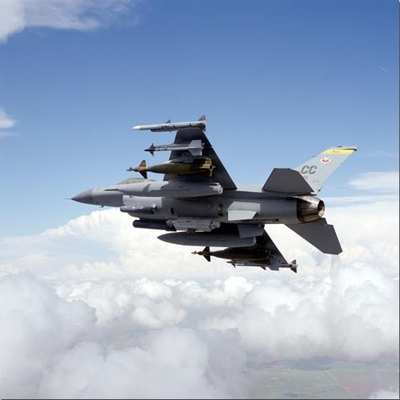Thu, Jul 17, 2003
 Astronics Corporation has been awarded a
follow-on contract from the U.S. government to supply spares and
replacement parts for the F-16 night vision instrumentation program
for which Astronics in recent years converted over 1,100 aircraft
to night vision capability. It also announced a development
contract for an undisclosed foreign government to upgrade the
lighting systems of certain fighters in their military fleet for
compatibility with night vision goggles.
Astronics Corporation has been awarded a
follow-on contract from the U.S. government to supply spares and
replacement parts for the F-16 night vision instrumentation program
for which Astronics in recent years converted over 1,100 aircraft
to night vision capability. It also announced a development
contract for an undisclosed foreign government to upgrade the
lighting systems of certain fighters in their military fleet for
compatibility with night vision goggles.
The follow-on spares contract with the U.S. government provides
for Astronics to supply spare parts for certain critical components
for up to ten years for the U.S. F-16 fleet, including such devices
as cockpit control assemblies, avionics keyboards and indicator
units. During the period 1999 through 2002, over 1,100 F-16
Fighting Falcons were converted with Astronics' lighting systems to
allow for the use of night vision goggles in the aircraft. The
conversion provides for the lighting systems to emit minimal
amounts of infrared energy and requires significant modification or
replacement of cockpit and external lighting by Astronics'
products, the leading technology for this type of application. The
spares contract value will depend on component failure rates
experienced by the U.S. Air Force. (This contract is in addition to
the F-16 spares contract valued at an estimated $30 million over a
ten-year period that was announced January 22, 2002.)
Astronics was also recently awarded a developmental contract
with an undisclosed foreign military to provide the night vision
instrumentation systems (NVIS) for its fleet of fighters. The award
covers certain design and development activities and two initial
ship sets of hardware. The contract is being administered through
the U.S. government's foreign military sales program.

James Kramer, Vice President of Astronics' Luminescent Systems
operation, commented, "Clearly our expertise with adapting manned
military equipment for the use of night vision goggles is
recognized world wide. The success of the conversion of the U.S.
F-16 fleet to night vision capability with our technology has
provided us in-roads to many other fleets around the world, as well
as to other applications such as in ground vehicles. With this
technology and the incremental technology we have developed through
our experience with this program, we continue to uncover solid
market opportunities, even in today's difficult market. We believe
we have much opportunity to continue to apply and advance our
technology, to expand the content we provide for every aircraft and
to continue to develop new approaches with such aircraft as the
Joint Strike Fighter and even still with the F-16, a versatile,
multi-role fighter that continues to be in high demand around the
world."
More News
Aero Linx: Transport Canada We are a federal institution, leading the Transport Canada portfolio and working with our partners. Transport Canada is responsible for transportation p>[...]
Gross Navigation Error (GNE) A lateral deviation from a cleared track, normally in excess of 25 Nautical Miles (NM). More stringent standards (for example, 10NM in some parts of th>[...]
From AirVenture 2017 (YouTube Edition): Flight-Proven Booster On Display At AirVenture… EAA AirVenture Oshkosh is known primarily as a celebration of experimental and amateu>[...]
Aircraft Parachute System (CAPS) Was Deployed About 293 Ft Above Ground Level, Which Was Too Low To Allow For Full Deployment Of The Parachute System Analysis: The day before the a>[...]
Also: 48th Annual Air Race Classic, Hot Air Balloon Fire, FAA v Banning 100LL, Complete Remote Pilot The news Piper PA-18 Super Cub owners have been waiting for has finally arrived>[...]
 ANN's Daily Aero-Linx (06.29.25)
ANN's Daily Aero-Linx (06.29.25) ANN's Daily Aero-Term (06.29.25): Gross Navigation Error (GNE)
ANN's Daily Aero-Term (06.29.25): Gross Navigation Error (GNE) Classic Aero-TV: Anticipating Futurespace - Blue Origin Visits Airventure 2017
Classic Aero-TV: Anticipating Futurespace - Blue Origin Visits Airventure 2017 NTSB Final Report: Cirrus SR22
NTSB Final Report: Cirrus SR22 Airborne Affordable Flyers 06.26.25: PA18 Upgrades, Delta Force, Rhinebeck
Airborne Affordable Flyers 06.26.25: PA18 Upgrades, Delta Force, Rhinebeck



